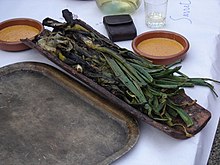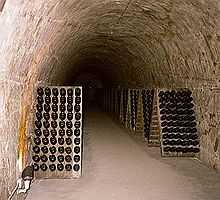
Catalan, known in the Valencian Community and Carche as Valencian, is a Western Romance language. It is the official language of Andorra, and an official language of three autonomous communities in eastern Spain: Catalonia, the Balearic Islands and the Valencian Community, where it is called Valencian. It has semi-official status in the Italian comune of Alghero, and it is spoken in the Pyrénées-Orientales department of France and in two further areas in eastern Spain: the eastern strip of Aragon and the Carche area in the Region of Murcia. The Catalan-speaking territories are often called the Països Catalans or "Catalan Countries".

Spanish cuisine consists of the traditions and practices of Spanish cooking. It features considerable regional diversity, with important differences between the traditions of each of Spain's regional cuisines.
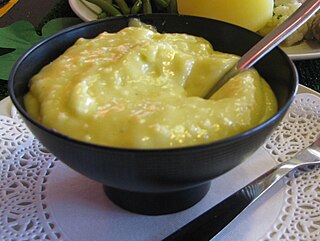
Aioli, allioli, or aïoli is a cold sauce consisting of garlic and olive oil; it is found in the cuisines of the northwest Mediterranean.

Pa amb tomàquet is a traditional food of Catalan, Aragonese and Balearic cuisine. Pa amb tomàquet is considered a staple of Catalan cuisine and identity. It is common in bars throughout the

Biscotti or cantucci are Italian almond biscuits that originated in the Tuscan city of Prato. They are twice-baked, oblong-shaped, dry, crunchy, and may be dipped in a drink, traditionally Vin Santo. Versions with smaller pieces are known as biscottini or cantuccini.
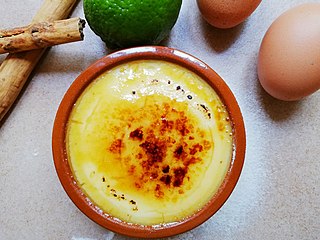
Crema catalana 'Catalan cream' or crema cremada 'burnt cream' is a Catalan and Spanish dessert consisting of a custard topped with a layer of caramelized sugar. It is "virtually identical" to the French crème brûlée. Like all custards, it is made from milk, egg yolks, and sugar. Some modern recipes add cornflour. It is typically flavored with lemon zest, cinnamon, or vanilla, and a crisp caramel crust is made by caramelizing sugar placed on top of the custard.

Valencian cuisine is a Mediterranean cuisine as cooked in the Valencian Community, Spain. Its basic ingredients are vegetables, seafood and meat. It is famous worldwide for its rices, such as paella, and its citrus fruits. The cuisine of neighbouring regions have given and received important contributions from Valencian gastronomy, amongst them Balearic cuisine, Catalan cuisine, Aragonese cuisine, Manchego cuisine and Murcian cuisine.

Balearic cuisine is a Mediterranean cuisine as cooked in the Balearic Islands, Spain. It can be regarded as part of a wider Catalan cuisine, since it shares many dishes and ingredients with Catalonia and the Valencian Community. Others view it as part of a more global Spanish cuisine. Traditional Balearic cuisine is rich in vegetables, cereal and legumes as well as being low in fats. A succinct selection of the primary dishes would be ensaimades, seafood and vegetable stews, sobrassada, coques, tombet, Maó cheese and wine.

Calçot is a type of green onion. The name calçot comes from the Catalan language. The calçot from Valls is a registered EU Protected Geographical Indication.

Tunisian cuisine, the cuisine of Tunisia, consists of the cooking traditions, ingredients, recipes and techniques developed in Tunisia since antiquity. It is mainly a blend of Mediterranean and native Punics-Berber cuisine. Historically, Tunisian cuisine witnessed influence and exchanges with many cultures and nations like Italians, Andalusians, French and Arabs.

The cocaCoc or Fogassa is a pastry typically made and consumed in Catalonia, the Aragonese Strip, most of Valencia, the Balearic Islands, Andorra and in French Catalonia.

Josep Lladonosa i Giró is a Catalan chef and food writer from the province of Lleida. He has been a chef since the 1980s. Throughout his career, he has also conducted extensive research on cooking techniques, products, recipes and the culture tied to eating in Catalonia. He has documented these aspects of Catalan cuisine since the Middle Ages, as exemplified in his book Llibre de Sent Soví. Lladonosa has diffused this knowledge through a large number of books and articles, some of which have been translated into languages including Spanish, English and French. He is also a famous gastronomy teacher, collaborating with individuals such as Joan Amades and Jaume Fàbrega. In 2003, he was awarded the highest Catalan honour by the Generalitat de Catalunya, the Creu de Sant Jordi.

Picada is one of the characteristic sauces and culinary techniques essential to Catalan cuisine. The technique is typically found in Catalonia and Valencia and subsequently Catalan cuisine and Valencian cuisine. It is not an autonomous sauce like mayonnaise or romesco, but it is added as a seasoning during the cooking of a recipe.

Flaó is a cheesecake or tart found in Spanish cuisine popular from Catalan speaking areas. It is claimed by Majorca, Ibiza and Formentera, with some controversy. Traditionally flaons were part of Easter family celebrations in Menorca, but now they are available all year round.

Joan Roca i Fontané is a Spanish chef, best known as founder and head chef of El Celler de Can Roca, awarded three Michelin stars in 2009. In 2013 & 2015, it was named the best restaurant in the world by the Restaurant Magazine. It was ranked second by the same magazine in 2011, 2012 & 2014.

The gastronomy of the province of Valladolid comprises the meals, their preparation, and the culinary habits of the province of Valladolid. It is based on barbecued and roast food, especially roasted Spanish cuisine. Wines of high quality highlight the meals.
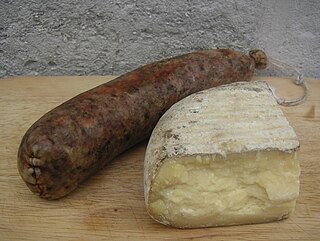
Menorcan cuisine refers to the typical food and drink of Menorca.

Albert Adrià Acosta is a Spanish chef. He is currently head chef of Tickets, a Michelin one-star restaurant in Barcelona and was formerly the head pastry chef of elBulli, in Roses on the Costa Brava. He has often collaborated with his brother, renowned chef Ferran Adrià.
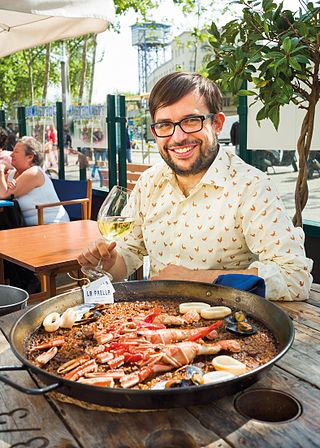
Josep Sucarrats Miró is a Catalan writer, specialized in gastronomy.







